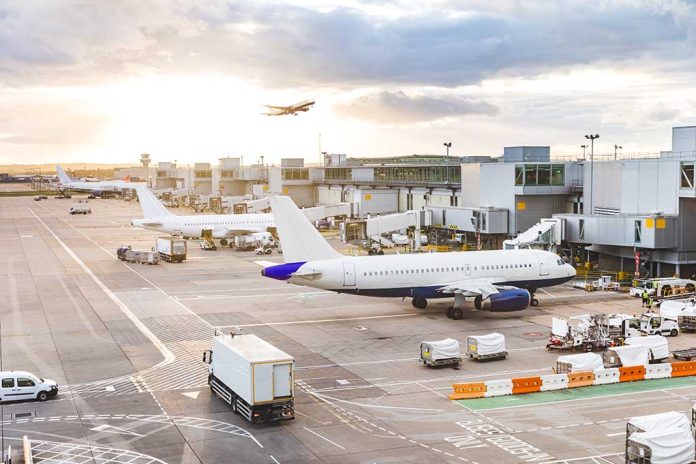
Americans must prepare for upcoming REAL ID requirements that will change how millions travel domestically, with the final deadline now set for May 2025 after multiple delays.
Key Takeaways
- Beginning May 7, 2025, U.S. travelers 18 and older must present REAL ID-compliant identification for domestic air travel and entering federal facilities.
- REAL ID-compliant cards are marked with a star or flag symbol in the upper right corner (or labeled “Enhanced”).
- Alternative acceptable identification includes U.S. passports, military IDs, and Enhanced Driver’s Licenses from Washington, Michigan, Minnesota, New York, and Vermont.
- The REAL ID Act originated from a 9/11 Commission recommendation to standardize security for state-issued identification documents.
- To obtain a REAL ID, applicants must provide documentation of full legal name, date of birth, Social Security number, two proofs of address, and lawful status.
REAL ID Deadline Finally Set After Multiple Extensions
The Department of Homeland Security has confirmed that May 7, 2025, will mark the final deadline for REAL ID compliance, ending a series of extensions that have delayed implementation since the law was passed nearly two decades ago. After this date, Americans will need to present REAL ID-compliant identification to board domestic flights and access certain federal facilities. This requirement stems from the REAL ID Act of 2005, which established minimum security standards for driver’s licenses and identification cards following recommendations from the 9/11 Commission to strengthen national security.
The federal government has emphasized that the deadline will not be extended again, making it crucial for travelers to prepare accordingly. REAL ID-compliant cards are visually distinguishable from standard identification, featuring a star, flag, or the word “Enhanced” in the upper right corner. According to the Department of Homeland Security, this standardization helps ensure that identification documents meet consistent security requirements across all states and territories.
Real ID deadline is just one month away — here’s what travelers need to know https://t.co/p8SDeC5C3w pic.twitter.com/xUqlxq8WoX
— New York Post (@nypost) April 8, 2025
Alternative Identification Options
Americans who prefer not to obtain a REAL ID still have several alternatives for domestic air travel and accessing federal facilities. U.S. passports and passport cards remain valid identification options regardless of the REAL ID implementation. Military IDs, Department of Homeland Security Trusted Traveler cards (including Global Entry, NEXUS, SENTRI, and FAST), and federally recognized tribal photo IDs will also be accepted. Additionally, Enhanced Driver’s Licenses issued by Washington, Michigan, Minnesota, New York, and Vermont are acceptable alternatives.
It is important to note that non-compliant identification will still be valid for driving, purchasing age-regulated products, accessing hospitals, visiting post offices, and other activities that do not involve federal facilities or air travel. However, planning ahead remains essential for those who rely on their driver’s license as their primary form of identification for air travel.
How to Obtain a REAL ID
The process for obtaining a REAL ID varies slightly by state, but all applicants must provide specific documentation to verify their identity. Required documents typically include proof of full legal name, date of birth, Social Security number, two proofs of current address, and evidence of lawful status. Most state DMVs recommend bringing original documents or certified copies rather than photocopies. Many states now offer appointments to streamline the application process and reduce wait times.
The Department of Homeland Security provides an interactive map on their website to help Americans locate their nearest DMV and understand their state’s specific requirements. While some states offer online pre-verification to expedite the in-person appointment, all applicants must ultimately visit a DMV in person to complete the REAL ID application process. Mobile Driver’s Licenses (mDLs) will be accepted by TSA until May 7, 2025, but after the compliance deadline, even digital licenses must meet REAL ID standards.
Historical Context and Implementation Challenges
The REAL ID Act was enacted in response to security vulnerabilities identified after the September 11, 2001, terrorist attacks. The 9/11 Commission specifically recommended strengthening standards for identification documents, as several of the hijackers had obtained fraudulent identification that helped them board aircraft. Despite the clear security imperative, implementation has faced numerous delays due to state-level compliance issues, technology challenges, and concerns about privacy.
The COVID-19 pandemic caused the most recent significant delay, pushing the deadline from October 2020 to May 2025. This extension gave states additional time to process applications while addressing pandemic-related limitations on in-person services. The Department of Homeland Security reports that all 50 states are now issuing REAL ID-compliant licenses and identification cards, though millions of Americans still need to upgrade their identification before the deadline arrives.









